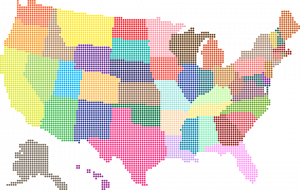
Originally posted 8/8/2017
Most people know that there’s a long and persistent history of racial and ethnic segregation in the United States. There’s less awareness of segregation of gays and lesbians, and gay neighborhoods often get treated as simply a matter of “choice”— much the way that queer identities have historically been treated as a “choice.”
Is it the case that gays and lesbians simply gravitate to similar areas and form gay “enclaves,” or is the segregation of gays and lesbians related to systematic inequalities? According to new work in Population Review by Dudley L. Poston Jr., D’Lane R. Compton, Qian Xiong, and Emily A. Knox, it’s a little of both.
To a degree, discrimination drives the segregation of gays and lesbians. The researchers point to religious intolerance and recent anti-sodomy laws as evidence that gays and lesbians are systematically excluded from some heterosexual communities. But Poston Jr. and colleagues don’t reject the possibility that some gays and lesbians segregate voluntarily. As homophobia decreases, gays and lesbians may still wish to take advantage of the “protective shield and social support” and “stronger political voice” afforded by self-segregation.
It’s likely that the dynamics of segregation might be different for gays and lesbians. Lesbians are more likely to have kids, and thus might voluntarily congregate in places with better school districts. But they’re also more likely to live in poverty than gay men, which leads to fewer living options.
Poston Jr., Compton, Xiong, and Knox examined the relationship between factors related to racial segregation and segregation by sexuality among 100 metropolitan areas with large gay and lesbian populations, using American Community Survey data from 2008 to 2012. The researchers estimated the percentage of gay or lesbian households that would have had to relocate within that metropolitan area for the number of same-sex and different-sex households to be proportional.
In all metropolitan areas examined, gay and lesbian households were segregated from heterosexual ones. On average, about 75 percent of gay male and 69 percent of lesbian couple households would have had to relocate within their metropolitan area to eliminate neighborhood segregation. The lowest estimate of segregation was between lesbians and different-sex couples in Madison, Wisconsin. Even there, though, just over half of lesbian households would have had to relocate for there to be no segregation.
Gay male households were more segregated from heterosexual households than were lesbian couple households in most cases. Provo-Orem, Utah, had the most segregation by sexuality: More than 90 percent of gay male households would have had to relocate to be proportional to heterosexual married and cohabiting couples in the population.
Gay and lesbian households are segregated from each other, too. In El Paso, Texas, which had the most segregation of same-sex households by gender, there was almost complete segregation between lesbians and gay men.
What factors predicted increased segregation between same-sex and different-sex households? For gays and lesbians, high prevalence of gay/lesbian couple households, high rates of Republican voters and Southern Baptists, and high poverty rates in their metropolitan areamade segregation more likely.
For gay men, they also found high population density, anti-sodomy laws, and a lack of non-discrimination laws predictive of increased segregation.
For lesbian households, high racial segregation also made their segregation from different-sex households more likely.
The only factors that predicted segregation between gay male and lesbian households were the gay male prevalence rate and the poverty rate. As the proportion of gay males in an area increased, segregation between gay male and lesbian couple households decreased. Conversely, as the poverty rate in an area increased, segregation of these two groups also increased.
The salience of poverty rates in these patterns suggests that segregation by sexuality is fueled at least partially by inequalities rather than the choices of gay and lesbian couples. But, to the extent that they have the option, gay and lesbian couples might choose to live in areas where they share political ideologies with others and can avoid discrimination.
There are still unexplained factors related to segregation by sexuality. Earlier qualitative research comparing the Castro with other gay enclaves, for example, found that what draws residents toward specific areas varies by the community, often in conjunction with more specific intersecting identities of the gays and lesbians that predominate in each space. Future research could examine individual communities to better understand how inequalities may be perpetuated through the residential patterns of gays and lesbians. But amid researchers’ calls for more research on the geographic distribution of gays and lesbians, there’s currently a policy shift away from data collection on LGBTQ demographics. The findings in this research by Poston Jr., Compton, Xiong, and Knox highlight that data on where sexual minorities live is crucial for understanding, and thus addressing, inequality more generally.
Braxton Jones eearned his MA in Sociology at the University of New Hampshire, and has begun a doctoral program at Boston University this fall. He serves as a CCF Graduate Research and Public Affairs Scholar.

Comments